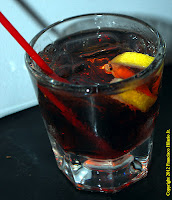Where Bond had ordered a Haig-and-Haig on the rocks for Felix, he ordered his now signature cocktail. It is in this initial offering of his now immortal spy series that we are introduced to Ian Fleming's signature cocktail: The Vesper. Here is how Bond orders the cocktail on page 44:
Bond insisted on ordering Leiter's Haig-and-Haig 'on the rocks' and then looked carefully at the barman.So Bond prefers a grain vodka to a potato vodka? Some of you might say to yourselves: What's the difference. If you have a gluten allergy then you would definitely prefer the potato vodka over the wheat vodka. Before I go into the differences between the potato and grain vodkas, I wanted to define what they are.
'A dry martini,' he said. 'One. In a deep champagne goblet.'
'Oui, Monsieur.'
'Just a moment. Three measures of Gordon's, one of vodka, half a measure of Kina Lillet. Shake it very well until it's ice cold, then add a large thin slice of lemon peel. Got it?'
'Certainly, monsieur.' The barman seemed pleased with the idea.
'Gosh that's certainly a drink,' said Leiter.
Bond laughed. 'When I'm...er...concentrating,' he explained, 'I never have more than one before dinner. But I do like that one to be large and very strong and very cold and very well-made. I hate small portions of anything, particularly when they taste bad. This drink's my own invention. I'm going to patent it when I can think of a good name.'
He watched carefully as the deep glass became frosted with the pale golden drink, slightly aerated by the bruising of the shaker. He reached for it and took a long sip.
'Excellent,' he said to the barman, 'but if you can get a vodka made with grain instead of potatoes, you will find it still better.'
Potato vodka is easy, its made with potatoes as the main base ingredient. Grain vodkas can be made from grains such as corn, wheat, rye, barley and others. There are vodkas such as the French vodka Ciroc that is made from grapes, the Milo Vodka from Kansas that is made from Sorghum, the Haku Japanese Vodka made with by white rice by Suntory and the Polish Żubrówka Bison Grass Vodka. I'm sure there are other things that vodka has been made from including fruits. Now on to the difference in the potato and grain vodkas.
For this I go to the VODKA 101 post from the Williams Sonoma Taste blog dated November 29, 2013. The article asks Rich Bubbico, the General Manager at Schiller’s Liquor Bar in New York for his thoughts on the differences between. Potato and grain vodkas:
There are many different varieties out there, but the most common vodka is made with grains. I think wheat is the most common, but rye and barley are frequently used as well. Wheat poses a problem for folks who have gluten allergies, so those who can’t ingest wheat should look for potato or corn vodkas.
I have tasted a variety of vodkas in my time, and I really don’t think there is a flavor difference between potato vodka and grain vodka. Keep in mind, vodka is a neutral spirit by definition; it lacks flavor or aroma. This is why it makes great cocktails: because it does not distract from the other flavors, it’s like having a blank canvas to start from.Some other impressions I've come across state that grain vodka, especially those made from corn tend to be the most flavorless of vodka while potato vodkas generally tend to be the most flavorful of vodkas. In the end it comes down to the distillation process. Better distillation produces a better product. This is especially so with Vodka. Now on to the naming of the cocktail.
Bond finally finds a suitable name for his cocktail upon meeting Vesper Lynd on page 52:
'Vesper,' she said. 'Vesper Lynd'
Bond gave her a look of inquiry.
'It's rather a bore always having to explain, but I was born in the evening, on a very stormy evening according to my parents. Apparently they wanted to remember it.' She smiled. 'Some people like it, others don't. I'm just used to it'
'I think it's a fine name,' said Bond. An idea struck him. 'Can I borrow it?' He explained his special Martini he had invented and his search for a perfect name for it. 'The Vesper,' he said. 'It sounds perfect and it's very appropriate to the violet hour when my cocktail will now be drunk all over the world. Can I have it?'
'So long as I can try one first,' she promised. 'It sounds a drink to be proud of.'So did Bond and Vesper finally enjoy her namesake cocktail? Alas they were not fated to have that cocktail together. But don't let me spoil the story for you, go and read the book. As for the cocktail itself...Many thanks to Ian Fleming to introducing this very potent cocktail to the world. Watch the video below to experience how master mixologist Alessandro Palazzi of the famed Dukes Hotel Bar in London makes the Vesper.
'Will have one together when all this is finished,' said Bond.
In doing so, Palazzi not only makes the Vesper Martini but gives us the behind the scenes history on the inspiration that Ian Fleming tapped into when creating the Vesper. Dukes is known to be the place where Ian Fleming came up with the idea for the Vesper.
You better believe that Dukes Bar is on the top of the list of places to visit on my London bucket list.
For the next post, I go into some of Bond's champagne expertise in Casino Royale.
For the next post, I go into some of Bond's champagne expertise in Casino Royale.
Until Then Happy Drinking,
SiscoVanilla
#SiscoVanilla
#SiscoVanillaHasABrewski
#SiscoVanillaBeerChronicles
#SiscoVanillaHasABrewski
#SiscoVanillaBeerChronicles











































